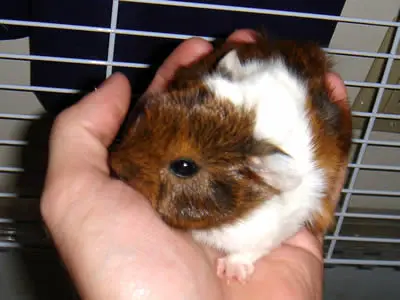Size
Guinea pigs are somewhat unusual among pet rodents because they grow much bigger than their furry cousins such as mice, rats, and hamsters. So what is considered a 'typical' or 'normal' size for a guinea pig? The following figures should give you a rough idea of how long your cavy should be at various stages in its life.
Birth
At birth, a guinea pig will generally measure around 8-10 cm (3-4 inches). You should expect some natural variation in size between the animals in a litter, with some bigger than others. The number of pups in the litter also has an effect on how big each baby is - a larger litter will tend to produce smaller offspring. This makes sense because the more babies there are, the less room they have to grow when inside the sow. Litter sizes tend to vary from 1 to 6 pups, with a typical birth producing 3 babies.
A baby guinea pig measures just 8-10 cm and easily fits into the palm of your hand. Image by Patrick Haney.
Growth
Guinea pigs grow very rapidly, and will double in size to around 15-20 cm (6-8 inches) after just 8 weeks. After this point their growth will slow somewhat, but they will still get significantly larger in a fairly short period of time, reaching around 20-25 cm (8-10 inches) after 16 weeks.
Maturity
In fact, your cavies will continue to grow until they are about 14 months old, by which time they will have reached around 20-30 cm (8-12 inches) long. At this point they are considered to be fully grown, and will not get any bigger.
A fully grown guinea pig can be up to 30 cm long. Image by cjnzja.
In the past, it wasn't unusual to find much larger cavies than you find today. However, over recent years they have tended to get a bit smaller because of too many people breeding from underage animals.
Guinea Pig Size Chart
For convenience, the following table summarizes these figures:
| Age | Size |
|---|---|
| Birth | 8-10 cm (3-4 inches) |
| 8 Weeks | 15-20 cm (6-8 inches) |
| 16 weeks | 20-25 cm (8-10 inches) |
| 14 months | 20-30 cm (8-12 inches) |
Measuring
To measure the size of your guinea pig, place it on a flat surface and place a ruler or tape measure next to it, running parallel to its body. Measurements should be taken from the tip of your pet's nose to its rear. Don't worry if your cavy moves around a lot and makes it difficult for you to get an exact measurement - a rough idea is more than sufficient.
Weight
As well as an increase in physical size, your pets will also grow in weight. A newborn pup weighs around 60-120 grams, and they will grow to reach anything up to 1,200 grams for an adult male (boar), with females (sows) weighing slightly less. This varies between different breeds, as some are naturally bigger and heavier than others.
Size as an Indicator of Age
If you buy your guinea pigs from a pet store, it isn't uncommon for them to be a little unsure about the age of the animals they stock. In these cases, it is extremely helpful to be able to use your knowledge of guinea pig sizes to estimate their true age. Among other things, this can help you avoid buying a pet which is really too young to be sold.
Handling
Guinea pigs' relatively large size makes them great pets for children, as they are much less likely to drop them than they might with smaller animals. Their temperament also helps, as they are mostly docile creatures who are more than happy to sit on your lap being stroked, and generally will not try to escape and jump away from you. Another benefit of their size is that they are less likely to crawl into small, hard-to-reach spaces - something that rodents are renowned for!
Cage Size
When buying a cage or hutch for your pets, you need to consider how big they will be when fully grown, and buy one with plenty of space to house them. If you consider this right from the start you will be saved any nasty surprises, and won't have to buy a second cage after just a few months when you discover that their current one is too small!
You should bear in mind that the figures on this page are offered as a guide only, and are not by any means definitive. If your guinea pig's size is slightly above or below the numbers given here then you shouldn't worry, as all cavies will vary somewhat from the average. However, if your pet is significantly bigger or smaller than these sizes, you should take it for a checkup at your local vet, as it may be a sign of a physical problem.

